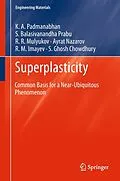This book combines the perspectives of materials science of Superplasticity, on the one hand, and those of design and mechanics, on the other, in order to provide a holistic view of materials, design, mechanics and performance which will lead to useful solutions of societal benefits, in addition to providing great intellectual challenges. After considering the experimental evidence for superplasticity in different classes of materials, the book discusses the physics-based models, along with their advantages and limitations. Then, the analyses for superplastic forming available in the framework of continuum mechanics, finite element analysis and numerical simulations are presented. Finally, the authors highlight some successful industrial applications. This book is recommended as a text book for courses on Superplasticity and as supplementary use for courses on Materials Processing, Manufacturing, High Temperature Deformation, Nanotechnology and Mechanical Behaviour of Materials. Persons working in Department of Materials Science and Engineering, Physics, Mechanics, Mechanical Engineering, Aerospace Engineering, Metallurgy, Ceramics and Geo-sciences are likely to find the book to be useful. It is also recommended as a reference source for practicing engineers involved in the design, processing and manufacture of industrial components, which exploit the unique properties associated with superplastic materials.
Autorentext
Prof. K.A. Padmanabhan is an Indian academician currently working as the Member (Physical Sciences), Research and Innovation Advisory Board & Advisor, TCS, and Aditya Birla S&T Company. He is a former Director, Indian Institute of Technology, Kanpur India.
Inhalt
1. HISTORICAL INTRODUCTION
1.1 Structural Superplasticity
1.2 Environmental Superplasticity
1.3 Materials in which superplasticity has been established
1.4 Industrial Relevance
2. MECHANICS OF SUPERPLASTIC DEFORMATION AND ASSESSMENT OF SUPERPLASTIC PERFORMANCE
2.1 Tensile and Compression Tests
2.2 Torsion and Others Tests
2.3 Constitutive Equations of Superplastics Flow
2.3.1 Transient and steady state flow
2.3.2 Strain-rate sensitivity and its effects
2.3.3 Equations of state for bi- axial loading
2.3.4 Equations of state for tri- axial loading
3. STRUCTURAL SUPERPLASTICITY INDIFFERENT CLASSES OF MATERIALS
3.1 Micro-grained Metals and Alloys
3.1.1 Mechanical Response
3.1.2 Microstructural Studies
a) Qualitative metallographic studies
b) Quantitative metallography
c) Cavitation and fracture behaviour
3.2 Intermetallics and Ceramic Materials
3.2.1 Mechanical properties
3.1.2 Micostructural characteristics
3.3 Dispersions-containing Metals, Metal-Matrix and Ceramic- Matrix Composites and High Strain-rate Superplasticity
3.3.1 Mechanical response
3.3.2 Microstructural studies
3.4 Severe Plastic Deformed and Nanostructured Materials
3.4.1 Mechanical response
3.4.2 Microstructural studies
3.5 Geological Materials
3.5.1 Mechanical Response3.5.2 Microstructural studies
3.6 Superplastic Flow in Different Classes of Materials: Similarities and Differences- An Assessment
4. ENVIRONMENTAL SUPERPLASTICITY
4.1 Experimental Studies
4.1.1 Macroscopic response
a) Transformation superplasticityb) Temperature cycling of anisotropic materials and neutron irradiation
4.1.2 Metallographic observations
4.1.3 Cavitation and fracture
5. THEORIES OF SUPERPLASTICITY
5.1Structural Superplasticity
5.1.1 Rheological and phenomenological analyses
5.1.2 Atomistic models for strain-rate controlling flow
a) Diffusion rate control
b) Dislocation process rate control
c) Grain boundary sliding rate control
d) Multi-mechanisms
5.2 Environmental superplasticity
5.2.1Phenomenological approaches
5.2.2 Mechanistic models
6. INDUSTRIAL APPLICATIONS OF SUPERPLASTICITY
6.1 Forming Operations
6.1.1 Forging and stamping
6.1.2 Extrusion
6.1.3 Processes involving the use of tensile forces
6.1.4 Powder metallurgical process
6.1.5 Hydraulic bulging
6.1.6 Sheet- thermoforming
6.1.7 Blow moulding
6.1.8 Deep drawing
6.1.9 Punch stretching
6.1.10 Superplastic forming-diffusion bonding
6.1.11 Hybrid processes
6.2 Theoretical Analyses of Superplastic Forming Processes
6.2.1 Analyses for bulk forming processes
6.2.2 Analyses for sheet forming forces
6.2.3 Regression, numerical, finite difference and finite element analyses
6.3 Industrial Applications
6.3.1 Superplastic alloy development and its exploitation in industry
6.3.2 Design and tooling (including the introduction of novel features)
6.3.3 Some examples of industrial components that exploit the unique characteristics of superplastic flow
APPENDIX
REFERENCES
SUBJECT INDEX